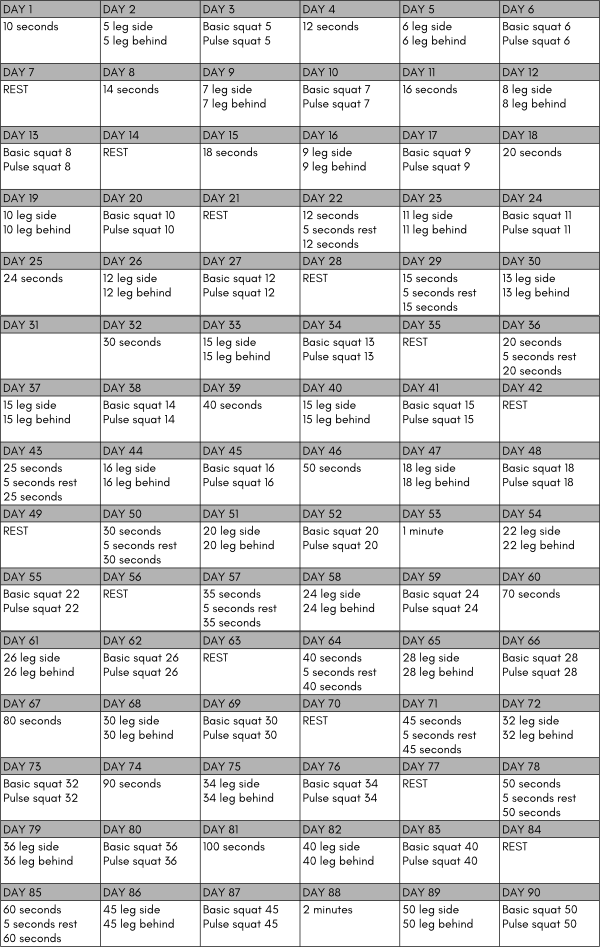
Weightlifting is an essential part to fitness, especially for beginners. There are many weightlifting methods, each with its own repetitions and sets. Beginners should concentrate on the first few months. This is why you need to use lighter weights and a proper technique. Ask a friend or trainer for help if you're new at lifting. Mix and match exercises such barbell squats/deadlifts, standing presses, deadlifts, and rows.
Strength training for beginners has the best advantage that you don’t have to be an athlete at first. Strengthening your bones will not only help you build muscle but also strengthen your bones. It can be intimidating at first. Women should start slowly and work their way up to advanced levels. Annie Brees, personal training coach, recommends a simple program that begins with bodyweight exercises such as sit-ups and pushups. For those who are more experienced, she suggests resistance bands or suspension-training systems.

After you reach a certain level in strength, it is time to start adding new exercises. For beginners, a strength training routine should include two to four exercises per muscle group for the upper body and three or four for the lower body. Experts suggest that you start with the larger muscle groups because they are the most difficult. However, smaller muscles are important as well. Remember that the harder the exercise, the better.
Once you've created a routine for your workout, you can begin adding weight to it. As a beginner, you should always strive to keep perfect form, which will help you build muscle faster. You don't have to be an expert at weight lifting if it is done correctly. With the right technique you can lift weights and build a strong body. It is important to be able to execute all exercises correctly.
Weightlifting is an effective way to burn body fat and gain lean muscle. For intermediate strength training, you should complete at least eight to twelve repetitions per set. Beginners should aim to increase repetitions. The more difficult the exercises are, the higher the repetitions. Regardless of whether you're a beginner or an expert, you should always keep in mind that you're training to build muscle.

For the best results in strength training, you should start with a basic workout using a light weight. Don't push yourself too hard or you might hurt your own body. For beginners, limit your workouts to 2 per week. This will help prevent injury. Make sure you practice proper form. It is important to practice with a partner. Once you have mastered a few movements, you can add more weights.
FAQ
Get immune enhancement with herbs and supplements
To boost immunity function, herbs and natural remedies are available. You can use ginger, garlic, echinacea oregano oil and vitamin C as examples.
These herbal remedies shouldn't be considered a replacement for medical treatment. Side effects include nausea, diarrhea and stomach cramps, headaches and dizziness.
How can you live a healthy life?
Living a healthy lifestyle involves eating right and exercising regularly. Healthy eating means avoiding sugary and processed foods. Exercise can help you burn calories and strengthen your muscles. Sleeping well improves concentration and memory. Stress management can reduce anxiety and depression. Fun is the key to keeping us healthy and happy.
Exercise: Good or bad for immunity?
Exercise is good for your immune systems. Exercise boosts the production of white blood cells, which can fight off infections. Your body also eliminates toxins. Exercise helps prevent diseases like cancer and heart disease. It can also lower stress levels.
However, exercising too much can weaken your immune system. Exercising too hard can make your muscles sore. This causes inflammation and swelling. In order to fight infection, your body must produce more antibodies. However, these antibodies can also cause allergic reactions and autoimmune diseases.
So, don't overdo it!
What is the most healthful lifestyle?
A healthy lifestyle means eating healthy foods, exercising regularly, sleeping well, and avoiding stress. If you follow these guidelines, you will be able to lead a long and healthy life.
It's easy to start small with your exercise and diet. You can lose weight by walking 30 minutes each day if you are looking to lose weight. For more activity, you can try swimming or dancing. You could also sign up to an online fitness platform like Strava, which tracks your activity.
Is it possible to have a weak immune system due to being cold?
According to some, there are two types: people who love winter or those who hate it. It doesn't really matter whether you love winter or loathe it. You might be wondering why it makes you miserable.
The truth is that our bodies are built to work best when it's warm. We evolved to thrive in hot environments because of the abundance of food resources.
But now we live in an environment that is very different from how our ancestors lived. We spend more time indoors than ever before, and are often exposed both to cold and heat extremes.
Our bodies aren’t accustomed to such extremes. So, when we do venture outside, we often feel exhausted, sluggish, or even sick.
There are many ways to avoid these side effects. Staying hydrated is one way to combat this. Drinking plenty of water will help you keep your body hydrated and flush out toxins.
Another important step is to ensure that you're eating healthy meals. Consuming healthy food helps maintain your body's optimal temperature. This is especially beneficial for those who spend extended periods of time inside.
You can also meditate for a few minutes every day. Meditation is a great way to relax your body and mind. It makes it easier for you to cope with stress and illness.
What's the difference between a calorie and kilocalorie?
Calories are units used to measure the amount of energy in food. Calories is the unit of measurement. One calorie is the amount of energy required to heat one gram water one degree Celsius.
Kilocalories is another name for calories. Kilocalories equal one thousandth of a calorie. 1000 calories equals 1 kilocalorie.
What is the difference in fat and sugar?
Fat is an important energy source, which comes from food. Sugar is naturally found in fruits and veggies. Both fats, as well sugars, provide the same number calories. But fats are twice as calories as sugars.
The body stores fats and they can lead to obesity. They can cause cholesterol buildup, which can lead you to heart attacks and strokes.
Sugars provide instant energy and are rapidly absorbed by the body. This causes blood glucose levels in the body to rise. High blood glucose levels can lead to type II diabetes.
Statistics
- WHO recommends reducing saturated fats to less than 10% of total energy intake; reducing trans-fats to less than 1% of total energy intake; and replacing both saturated fats and trans-fats to unsaturated fats. (who.int)
- WHO recommends consuming less than 5% of total energy intake for additional health benefits. (who.int)
- The Dietary Guidelines for Americans recommend keeping added sugar intake below 10% of your daily calorie intake, while the World Health Organization recommends slashing added sugars to 5% or less of your daily calories for optimal health (59Trusted (healthline.com)
- According to the Physical Activity Guidelines for Americans, we should strive for at least 150 minutes of moderate intensity activity each week (54Trusted Source Smoking, harmful use of drugs, and alcohol abuse can all seriously negatively affect your health. (healthline.com)
External Links
How To
What does the "vitamins” word mean?
Vitamins are organic compounds found naturally in food. Vitamins allow us to absorb nutrients from food. Vitamins cannot be made by the body; they must be taken from food.
There are two types of vitamins: water soluble and fat soluble. Water-soluble vitamins dissolve readily in water. These include vitamin C (thiamine), Vitamin B1 (riboflavin), Vitamin B2 (riboflavin), Vitamin B3 (niacin), Vitamin B6 (pyridoxine), Vitamin C, B1 (thiamine), Vitamin B2 (riboflavin), Vitamin B3 (niacin), and Vitamin B6 (pyridoxine). Fat-soluble vitamins can be stored in the liver or in fatty tissue. Examples include vitamin D, E, K, A, and beta carotene.
Vitamins are classified based on their biological activity. There are eight major types of vitamins:
-
A - Vital for normal growth and maintaining good health.
-
C is important for nerve function and energy production.
-
D - necessary for healthy bones and teeth.
-
E is necessary for good vision, reproduction.
-
K – Required for healthy nerves & muscles.
-
P - essential for strong bones, teeth and tendons
-
Q – aids digestion of iron and iron absorption
-
R - necessary for making red blood cells.
The recommended daily allowance (RDA), for vitamins, varies depending upon age, gender, or physical condition. The U.S. Food and Drug Administration (FDA) sets the RDA values.
For adults aged 19 and older, the RDA for vitamin B is 400 micrograms daily. For fetal development, pregnant women need 600 mg per day. Children ages 1-8 require 900 micrograms per day. For infants younger than one year, 700 micrograms are required daily. However, this number drops to 500 micrograms each day for children aged 9-12 months.
Children aged between 1-18 years require 800 micrograms of sugar per day, while overweight children need 1000 micrograms. Children who are underweight receive 1200 micrograms every day to meet their nutritional requirements.
Children 4-8 years old who have anemia must consume 2200 micrograms of Vitamin C daily.
2000 micrograms per person is necessary for general health. Breastfeeding or pregnant women require 3000 micrograms per daily due to higher nutrient demands.
1500 micrograms are required daily by adults over 70 because they lose approximately 10% of their muscle each decade.
Women who have been pregnant or are lactating require more than the RDA. Pregnant mothers need 4000 micrograms per daily during pregnancy and 2500 after giving birth. Breastfeeding mothers need to consume 5000 micrograms every day when breastmilk has been produced.